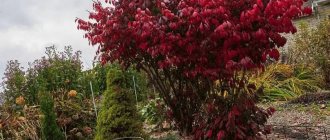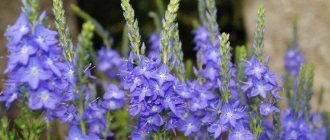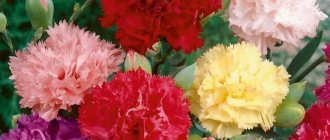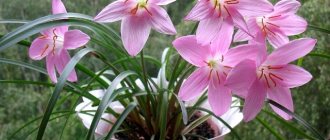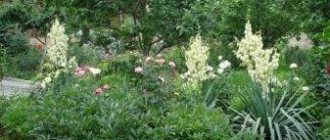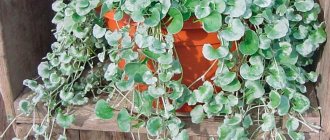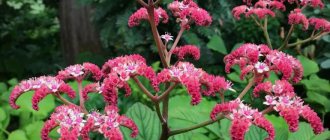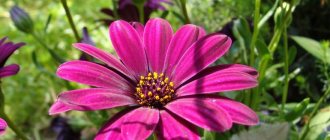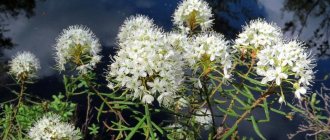One day at the city market I saw a plant that amazed me with unusually shaped flowers: small pink hearts decorated with a white “droplet” in the middle.
It was a magnificent dicentra. Dicentra is a worthy decoration for any flower bed
Lively girls and older, businesslike women lured us, their first morning shoppers, by enthusiastically praising the goods. Indeed, the choice of flowers was huge: from the modest violet and lush aster to the proud narcissus and exotic freesia. They sold a lot of things for every taste and color: flowers grown in the nursery, seedlings, seedlings and seeds. But, having seen the dicentra, I could no longer take my eyes off its lovely heart-shaped flowers and openwork leaves.
Later, I learned that there is a legend: the beautiful Jeannette got lost in the forest, and a handsome young man saved her and brought her home. When leaving, he kissed the girl, and since then she has been eagerly awaiting the return of the savior. However, after some time, Jeannette saw a richly decorated procession on the outskirts of the village. It turned out to be a wedding procession, and in front was the same young man with another girl. Jeanette staggered, fell to the ground, and her heart split with pain. It was in that place that the dicentra grew, which in different countries is poetically called “broken heart”, “Jeannette’s heart”, “flower of the heart”.
Of course, I wanted to place such a miracle in my dacha. This unpretentious perennial with a height of 30 cm to 1.5 m (depending on the variety) has more than twenty garden varieties. If I had the opportunity, I would probably buy everything. But for the first time I had to limit myself to two types: to see how they would take root.
Dicentra with white flowers
I chose two dicentras: magnificent and beautiful. While buying seedlings, I was surprised to learn that ten years ago this unusual flower was forced out of Russian gardens by all sorts of overseas exotics. Today, the dicentra has returned to our lands again. They decorate gardens with it, it lives on home windowsills, in winter gardens, and so on. Moreover, all types of plants are very unpretentious and settle well in a new place.
My beauties also took root, grew up to please everyone, and in the very first year of planting they pleased me with small tassels of inflorescences. These amazing flowers refresh my modest garden; they are the first to greet the arrival of the spring sun after long frosts.
The flowering period of the magnificent dicentra lasts from early May to mid-June; beautiful dicentra pleases the eye from early summer to autumn. After flowering, the aboveground part of both “falls asleep” until next spring. It happens that they bloom again in August and bloom until the end of September. Such a pleasant surprise becomes a real holiday for my entire family.
Ads by
general information
Now it’s difficult to say exactly where such a bizarre flower came to us from. But Japan is traditionally considered the birthplace of the Broken Heart. Since then, dozens and even hundreds of annual and perennial varieties have appeared, but the heart-shaped buds remain unchanged.
The Broken Heart flower has a very strong and developed root system, which allows it to adapt to different conditions. The stems can be straight or branched, up to 100 cm high. The leaves differ in shape, size and shade. The flowers are most often pink or white.
Another nice feature of the plant is that it can bloom twice a year. To do this, it is enough to immediately remove faded buds and flower stalks so that they do not drain resources.
Photo: artmaki.su
Botanical description of dicentra
The genus Dicentra consists of 20 species. Under natural conditions, it is found in the Far East, eastern China, and also in North America. Externally, the plant looks very beautiful:
- Height – from 30 cm to 1 m.
- The flowers are heart-shaped, with two spurs. Their diameter is 2 cm. The shape is slightly flattened, the tones are different. They are located in the form of inflorescences-tassels on a long stem.
- The leaves are green, with a slight blue-gray tint.
- The root is powerful and grows deep.
- The fruit is a small capsule, 3.5 cm long. It contains from 2 to 8 oblong black seeds. They are suitable for planting for 2 years. But it is quite difficult to germinate.
Types of Flower Broken Heart
Speaking about the varieties of this unusual and bizarre flower, I would like to first highlight several main categories. It is on their basis that modern varieties and hybrids are bred.
Spectabilis
Or, as we call it, the magnificent dicentra. This is the tallest species with powerful large bushes and dissected leaves. The height easily reaches 1 m. Even after flowering, the plant retains its decorative appearance.
Photo: ogorodmechty.com
Eximia
This variety is sometimes called Bleeding Heart. And all because the flowers intertwine all shades of pink and purple. Dicentra is exceptionally or excellently resistant to heat and is not afraid of temperature changes.
Photo: raiclimat.ru
Peregrina
She is a wandering dicentra and a real relic, because her ancestors were known more than a thousand years ago. This is a very tiny plant, but with large white, pink or purple flowers.
Photo: botanichka.ru
Formosa
Or the dicentra is beautiful. This is a compact and very elegant species with a height of only 40 cm. There are very delicate and beautiful shades of cream, milky, pastel pink and even red.
Photo: floribunda.ru
Scandance
The original liana-like form of the so-called climbing dicentra. Creeping shoots grow up to 2 m. There are varieties with rare shades, like golden, but this is still the same Broken Heart in shape.
Photo: zabor22.ru
Canna flower (60 photos): types, proper care and planting
Dicentra beautiful Dicentra formosa
Dicentra beautiful Dicentra formosa photo
Her homeland is British Columbia. The height of the plant is 30 cm. It forms leaves in a “bunch” near the root. The leaves are pinnate, carved, located on high petioles. Their color is green, the lower part has a bluish tinge. The arrow forms long (15 cm) inflorescences. The flowers are violet-pink, their diameter is 2 cm. Flowering is long-lasting (last days of May - end of August).
This species includes many different varieties. Most of all, flower growers liked two of them:
- King of Hearts - the flowers are bright pink, the petals are curved outward, like a bell. The leaves are feathery, bluish-green.
- Aurora - its flowers are painted in two tones: white at the bottom, creamy pink at the top, near the peduncle.
Dicentra cuccularia
Dicentra cuccularia photo
Its natural habitat is the states of Oregon and Washington. The plant reaches a height of 30 cm. The flowers are white, with elongated spurs. The leaf rosette is lush, dark green, with a gray tint. This type of flower is often grown as a potted plant.
This species includes the Pittsburgh variety. Its flowers are pink, with long spurs. Their shape resembles a bunny's ears.
Dicentra chrysantha
Dicentra chrysantha photo
Found naturally in Mexico and the Californian hills. It differs from previous varieties in its high “growth” - from 45 cm to 1.5 m. Its flowers are golden yellow. Two petals are curved outward. At home, the plant is capricious and requires careful care. In his native places he likes to settle on lands damaged by fires.
Dicentra uniflora
Dicentra uniflora photo
This species does not have lush inflorescences. Only individual pale pink flowers on stems. This is also an alien from North American lands. In its homeland, the flower was nicknamed “ox’s head” because of its shape. The two curved petals resemble the ears of a bull, and the flower itself resembles its head. Flowering begins in February and ends in July. Its originality requires sacrifice - it is a very difficult species to grow.
Dicentra peregrina
Dicentra peregrina photo
Small dissected leaves, reminiscent of wormwood, with the same bluish-gray tint, are collected in a lush basal rosette. The plant is low-growing, up to 15-20 cm in height. On tall bare peduncles there are paniculate inflorescences with 5-7 heart-shaped flowers. The petals are voluminous at the top, narrowed at the bottom and twisted outward.
Dicentra canadensis
Dicentra canadensis photo
Dicentra canadiana pleases with delicate inflorescences of pure white color; they look very noble, adding special romance to any composition in garden design.
Dicentra whitish-yellow Dicentra ochroleuca
Dicentra whitish-yellow Dicentra ochroleuca
The species is distinguished by dense massive inflorescences with many elongated flowers. The white petals have a dirty yellow tint and are slightly tinged with purple at the edges.
Caring for a Broken Heart Flower
This may sound unexpected, but a broken heart does not require special attention and care. The flower feels great in our latitudes and it is enough to choose a good site for it with good soil.
Temperature and lighting
There are no fundamentally important recommendations on any of these points. The Broken Heart flower blooms spectacularly in the shade and in the sun, and only the duration of this flowering changes. Individual requirements are found only in rare breeding varieties.
Photo: nashgazon.com
Watering
But it’s still worth paying a little more attention to watering. A broken heart does not tolerate drought or too much humidity equally well. In the first case, growth slows down, and in the second, diseases develop. So always focus only on the condition of the soil.
Photo: distano.ru
The soil
To ensure that the plant enjoys lush and long flowering, dig up the soil with humus from autumn before planting. You definitely need a good drainage layer, and for too heavy soil - vermiculite, sand or other loosening agent.
Photo: nagrunte.ru
Fertilizers and fertilizing
Throughout the season, the Broken Heart flower responds very sensitively to feeding. Apply fertilizers every 3-4 weeks in the spring, gradually changing the composition. First, complex fertilizers for the growth of green mass, and then potassium and phosphorus for flowering. In the fall, nitrogen is needed again so that the plant accumulates resources for the next year.
Photo: nagrunte.ru
Wintering
There are many winter-hardy varieties that can easily overwinter directly in the ground without additional problems. But we recommend covering them with peat or spruce branches in case of a snowless winter or sudden spring frosts.
Photo: floralacres.ca
Transfer
As the Broken Heart flower grows and ages, it needs to be replanted. Firstly, the soil will exhaust its capabilities, and secondly, in the process you can divide and rejuvenate the bush. Remember that for all the power of the root system, it is very fragile. Transplantation is done strictly with an earthen lump.
Photo: zabor22.ru
Lilies of the valley (50 photos): types, planting and proper care
We create growing conditions
The culture is quite unpretentious with the exception of certain species. She loves sunny places with light shade. The soil is fertile and light.
In flower beds that are constantly illuminated by the sun, dicentra will bloom quickly, but it will also fade just as quickly. In the shade, the inflorescences gradually gain strength and bloom for a long time. The colors are bright and rich. Therefore, gardeners select a light area with shading.
The plant is not picky about the soil - it should be light and enriched with organic matter and mineral fertilizers.
Heavy soil is diluted with coarse sand or peat. The ground is moist but not soggy. Dicentra does not tolerate swamps. Treats feeding well. The crop is often planted along borders or in flower beds. Dicentra will grow in almost any area of the garden, the main thing is to give it a bright, moist and slightly shaded place.
Planting and propagation
The Broken Heart flower is quickly and easily propagated by cuttings from young shoots. Soak them in the stimulator according to the instructions and plant them in containers with loose soil mixture. Moisten the seedlings, cover with film and leave for a month, watering as they dry. Remove the film, and in the spring plant the seedlings in a permanent place.
The second method is dividing the bush. Here it is very important to carefully divide the root so that young buds remain on each division. Let the rhizome dry slightly and plant future bushes in new places.
Photo: lisky.org.ua
How to propagate dicentra?
This plant is propagated in several ways:
- root division;
- seeds;
- cuttings.
The first of them has already been discussed in the previous section. But there is another option - propagation by seeds. This technique is more complex. Requires skill and experience. It is not popular among amateurs. Such breeding can be done by professional gardeners. But if you wish, you can master this breeding technique.
Pest and disease control
Most often, only slugs, snails and mole crickets suffer from a broken heart. But routine treatment with insecticides will allow you to forget about this problem.
The appearance of deformed, chaotic spots on leaves and shoots may be a symptom of spotting. Unfortunately, this is an incurable virus, so the diseased plant must be removed by the roots and the soil disinfected with chemicals.
A more common situation is fungus and rot, which develop due to excess moisture in the soil. But even here everything is simple: remove the affected areas, treat the cuts with charcoal and spray the plants with fungicides.
The most dangerous is root rot, because in the later stages the flower cannot be saved. So regularly inspect your plantings for suspicious spots and the structure of shoots and leaves in general.
Photo: pnwhandbooks.org
Celosia (60 photos): types, planting and proper care
Wintering plants
A very important point in growing flowers is preparing the plant for winter. Despite the frost resistance and strength of the shrub, in wet and cold winter conditions they need additional preparations. In order for the dicentra to overwinter quietly, it is necessary to cut off the entire above-ground part of the plant in the fall, practically leaving not the slightest protruding trunks. Stumps should not exceed 2 cm.
To completely preserve the plant, it is necessary to cover the place where it grows with a layer of peat 5-7 cm deep. If the peat layer is poured higher, the roots of the dicentra will simply trample. If it is not possible to cover the plant with peat mulch, you can simply dig the bush with soil and cover it with a layer of dry leaves.
Flower Broken Heart – photo
The Broken Heart flower is a real curiosity in the garden. It simply has no competitors with the same unusual type of inflorescences and buds. Just look!
Photo: gavrishira.blogspot.com
Photo: wallpapersafari.com
Photo: rachelwilliamsonline.com
Photo: victoriadailyphoto.blogspot.com
Photo: dacha73.ru
Photo: plantarium.ru
Photo: asienda.ru
Photo: nn.ru
Photo: pinterest.ru
Photo: polezno-znat.ru
Photo: thespruce.com
Photo: ladyflor.ru
Photo: lovely-dom.ru
Photo: sady-msk.ru
Photo: commons.m.wikimedia.org
Photo: flo.discus-club.ru
Photo: commons.m.wikimedia.org
Photo: zen.yandex.ru
Photo: reddit.com
Photo: zen.yandex.ru
Photo: oir.mobi
Photo: fotoshkola.net
Photo: jhoppers.japanhostel.net
Photo: windowssearch-exp.com
Photo: photo.99px.ru
Photo: avto.goodfon.ru
Did you like the post? Subscribe to our channel in Yandex.Zen, it really helps us in our development!
